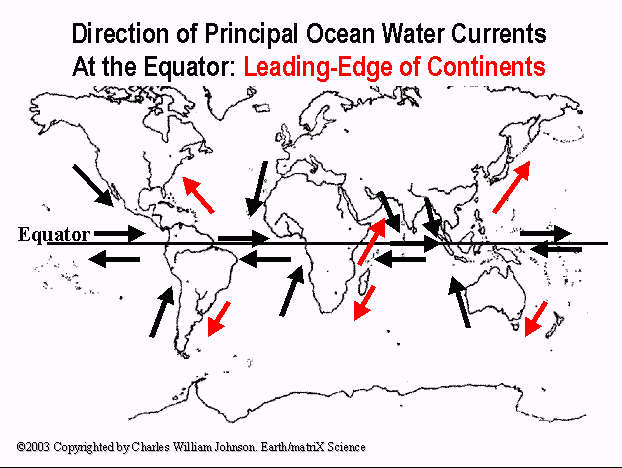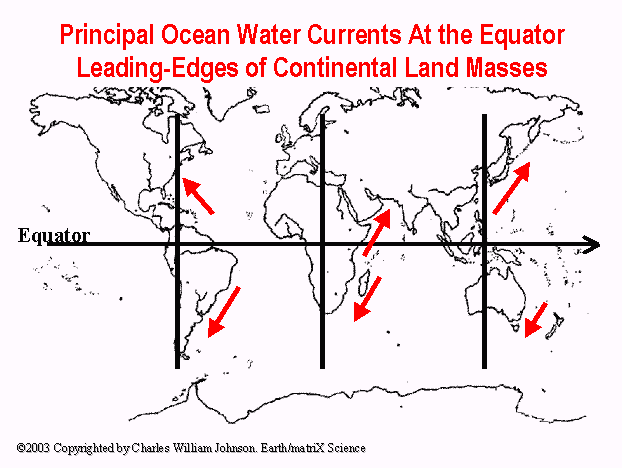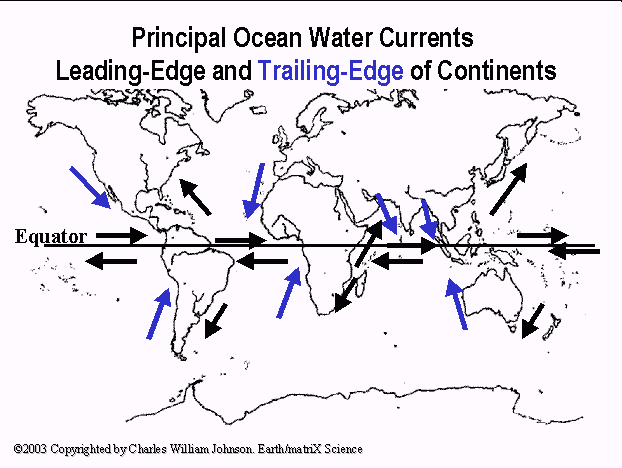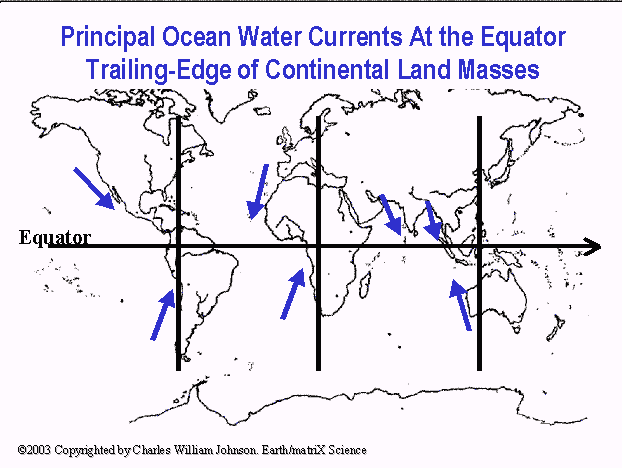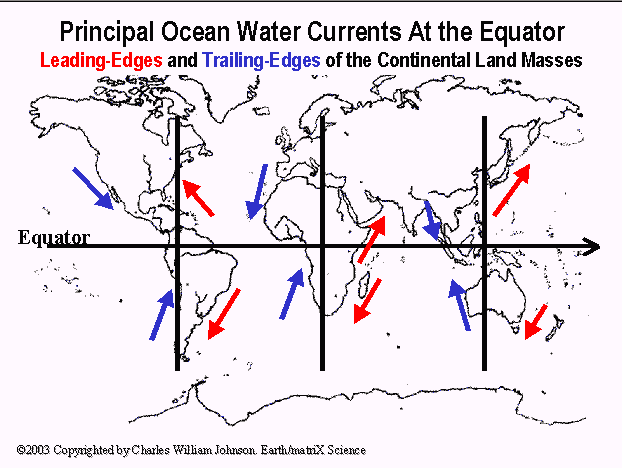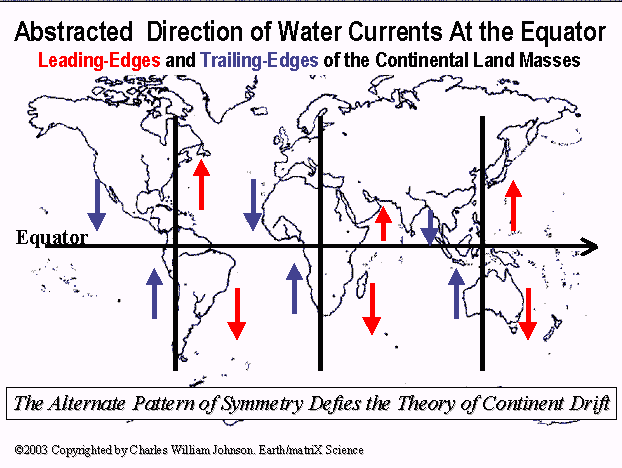
QUESTIONING THE THEORY OF CONTINENTAL DRIFT
Ocean Currents:
Alternating Patterns of Symmetry
Charles William Johnson
The principal alternating water currents of the Oceans on Earth reflect patterns of symmetry in accordance with the spiraling path of the Earth around the Sun. If we look at a projected map of the Earth as follows, we see that the main ocean currents move away from the Equator along the right-side of the continental land masses. And, on the trailing edge of the continental land masses, the left-side facing the viewer, the main water ocean currents move towards the Equator ---as illustrated by the arrows in the following drawings. Given the fact that the Earth is spinning towards the right, in a clockwise direction from the viewer, then the leading edge pattern would appear to reflect the forces exerted in that sense.
Ocean Currents:
Alternating Patterns of Symmetry An Observation About Continental Drift
From the previous drawings, the main ocean currents present
discernible patterns in relation to the leading-edge and trailing-edge
of the continental land masses of Earth. These patterns occur in relation
to the spin resulting from the rotation and the revolution of the Earth’s
movements around the Sun as the Solar System travels throughout the Galaxy.
It is difficult to understand how the random-like splitting up of Pangaea
may have produced such symmetrical, alternating oceanic patterns.
The symmetry of the oceans’ water currents, as illustrated, suggest that these processes have been going on since the beginning of the Earth’s existence as a cooled-down planet of hot gases. The alternating patterns of the water currents of the Oceans are evidentiary data that suggests to us the possibility that the theory of continental drift as posed by Alfred Wegener must be discarded.
One can only imagine what the water currents may have been like on an Earth that had all of its land mass clumped together on one of its “sides”. We have not observed any theoretical reconstruction as to what the nature and directional flow of the oceanic water currents may have been on such a lop-sided Earth.
One might speculate about the amount of force that would have been involved in a similar rotational pattern were all of the Earth’s water to have been on one area of the Earth, with the land mass clumped together on another single area of that same Earth. We have not observed in the literature what the theoretical nature may have been of the tug-of-war of gravity among the Earth, the Sun and the Moon, with such a disproportionate distribution of water expanse and land mass (Pangaea) on the Earth some 250 million years ago. Further, one can only imagine the amount of force that would have been unleashed by the splitting of the super-continent and the intrusion of the oceanic waters along the Eastern coastline of what are today called South American and the Western coastline of Africa.
One can only imagine how a nearly perfect sphere of hot gases cooled down to a lop-sided, surface of one-quarter land mass and a concentrated three-quarters of water expanse. One can only imagine the physics of such a phenomenon.
Within the theory of plate tectonics and sea-floor spreading the concept of “heat convection” is called into play as the cause for these phenomena. One can only wonder, then, how the uniform physics of heat convection may have produced a cooled down Earth that was lop-sided, possibly suggesting that one “side” of the sphere of hot gases cooled down faster than the other “side” of the sphere. One would surely need to explain how the relationship of the gravity among the Sun, the Moon and the Earth behaved during the period from the initial lop-sided sphere throughout the entire process of producing the present-day equilibrium among these gravitational forces.
One would necessarily have to explain every step of the way regarding the manner in which the continents were torn asunder and the water expanses crept throughout the now oceanic crevices, leaving the eastern coastline of South America and the western coastline of Africa nearly intact to more than a 90-percent match as geologists claim they share today.
One would have to explain how the tremendous force of the waters of the oceans have had such little effect upon these coastlines in over 250 million years, when we observe the everyday effects of erosion on the coastlines of all continental masses today. One would necessarily have to explain how the uniform forces of heat convection create random-like events, such as the splitting of the super-continent (Pangaea), and yet produce extremely well-defined patterns of symmetry within the identified randomness. In our mind, the theory of continental drift cannot explain these events, as it has not even attempted to address them.
The uniform forces have created the placement and development of the land masses and the water expanses on Earth. These uniform forces are readily identifiable, two of which we have treated in this essay: the rotational and revolutionary direction of the Earth in its orbit around the Sun, spiraling throughout the Galaxy. These forces, along with other spacetime/movement events, produce the identifiable patterns of symmetry that we have been illustrating throughout the Earth/matriX series on continental drift. These patterns of symmetry suggest to us, that the continents have not drifted apart from one another during the past 250 million years, and they also suggest that the continents are not drifting together to form another super-continent some 250 millions years from now.
The patterns of symmetry suggest to us that the continents have been shifting back and forth in situ for millions and even billions of years, and shall continue to do so, until they are possibly worn away by the waters of the oceans.
The random drifting of continents on the face of the Earth would not produce necessarily any particular patterns of symmetry in their lay-out. Quite the opposite: one would expect extreme randomness in their composition and development. One would not expect symmetry of any kind other than unexplainable accidental symmetry. However, our studies illustrate innumerable patterns of symmetry among the geographical points of the Earth as we shall illustrate in future essays.
Ocean Currents: Alternating Patterns of Symmetry
Earth/matriX Science
ISBN 1-58616-347-7
©2003-2013 Copyrighted by Charles William Johnson All rights reserved.
This Earth/matriX essay was written in 2003, in which I call attention to the symmetry in the Earth`s ocean currents. The theses regarding symmetry in the ocean currents are confirmed in a map from 2010 that I found recently about GOCE data illustrating the symmetry of the Earth`s ocean currents, made by R. Bingham et.al. Reproduced here in fair use.
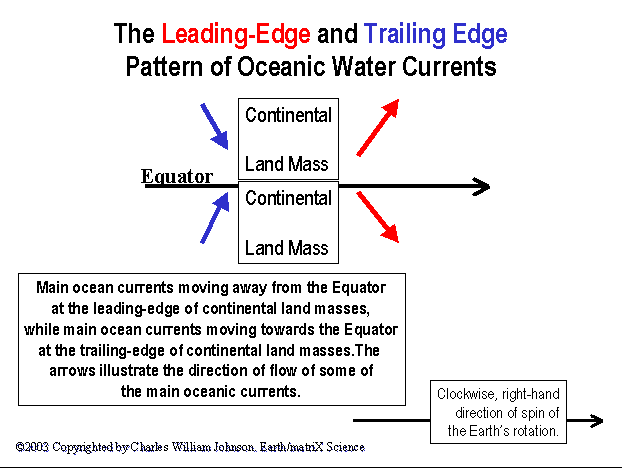 |
|||||||
|
Goce gravity mission traces ocean circulation. (click)
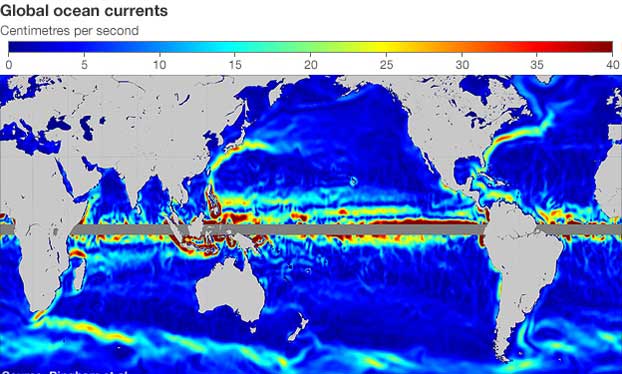
By Jonathan Amos Science correspondent, BBC News, San Francisco
21 December 2010
Dr Rory Bingham from Newcastle University, UK
(click)
Dr Bingham presented his ocean circulation data using the latest information from Goce at the recent American Geophysical Union (AGU) Fall Meeting, the largest annual gathering of Earth and planetary scientists. |
EVENTPOINT COSMOGEOGRAPHY Eventpoint Cosmogeography, a new study, opens up a distinct line of inquiry into the geography of the Earth. Charles William Johnson, from Earth/matriX, Science Today, questions the theory of continental drift by examining the distances between geographical extreme points and selected cosmogeographical event points. The translation and centrosymmetries of geographical coordinate points suggest the fact that the continents undergo movement, but that they have not drifted randomly on the face of the Earth for the past 250 million years as proposed by Alfred Wegener nearly a century ago. The symmetry between extremepoints and eventpoints illustrated in this study suggests that continental drift theory must be reconsidered, possibly abandoned. Eventpoint Cosmogeography |
Charles William Johnson e-mail johnson@earthmatrix.com
